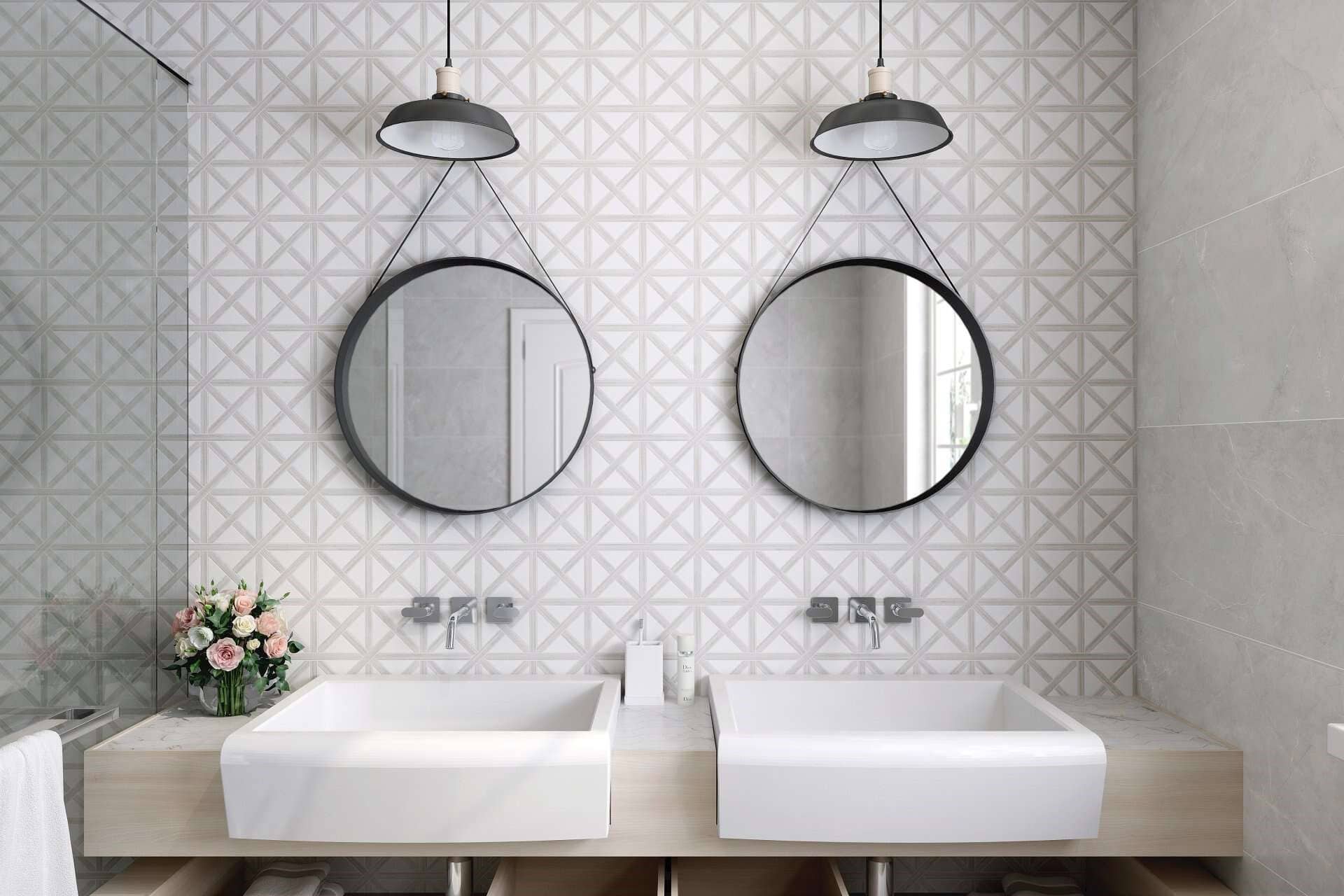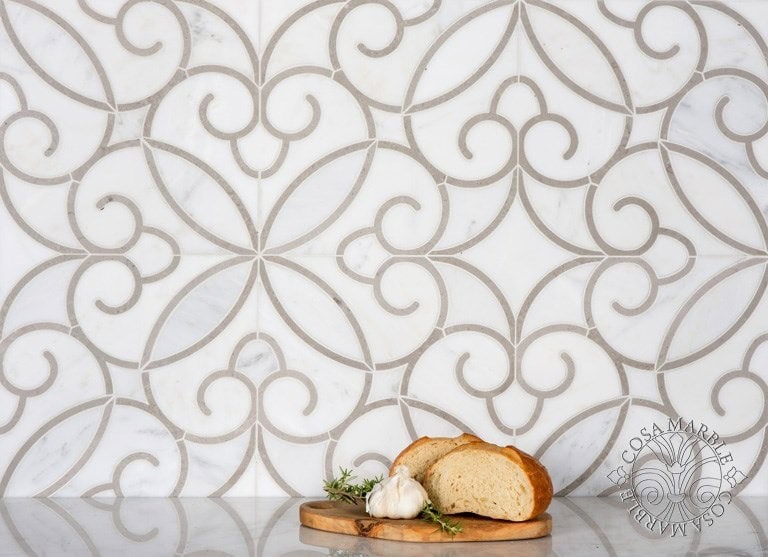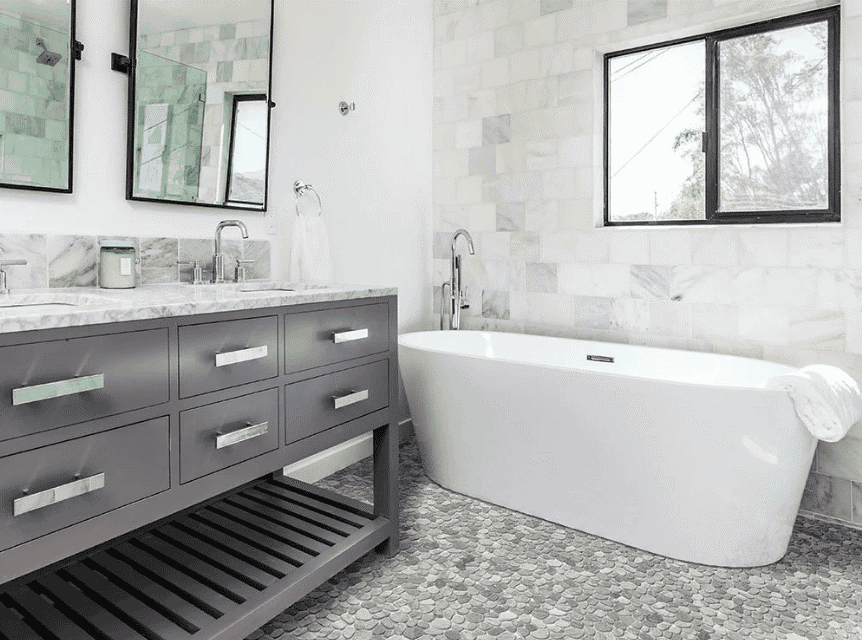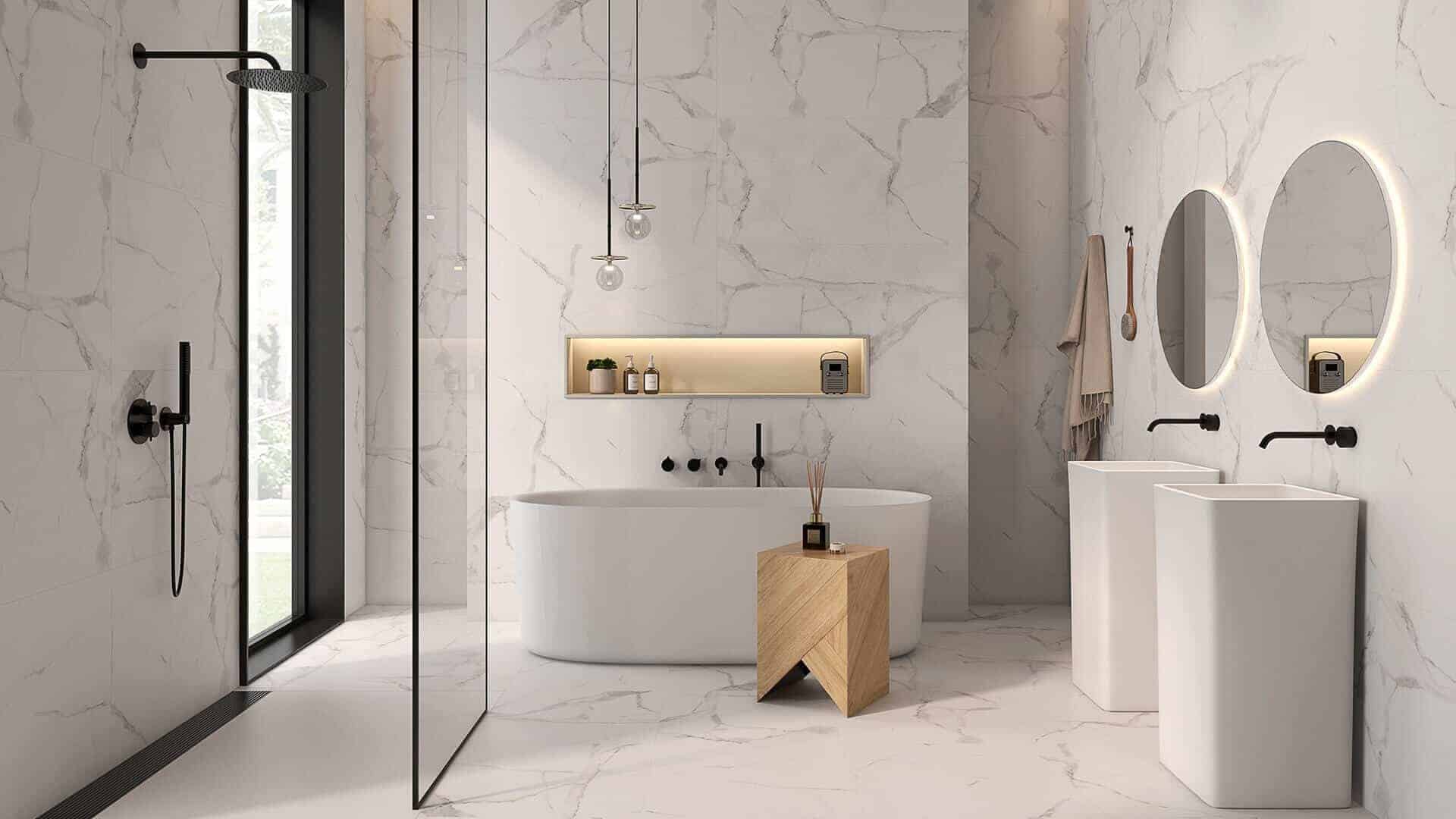
Marble is the material people ask about most when they visit Med Tile’s Fairfield showroom—and for good reason. Few surfaces offer the same combination of natural beauty, design versatility, and enduring appeal.
From a checkerboard foyer in Montclair to a serene primary bath in Summit or a crisp backsplash in Livingston, marble has the range to elevate every room and architectural style across North Jersey.
In this comprehensive guide, we’ll demystify marble and show you exactly how to use it well—room by room and style by style—so you can create a home that feels intentional, timeless, and unmistakably yours.
Marble 101: What It Is, Why It’s Loved, and How to Think About Performance
Marble 101 is your quick primer on the stone’s makeup, its aesthetic strengths, and how it performs in real North Jersey homes. In the next sections, we’ll outline the basics, why homeowners love it, and how to set it up for success with the right finish and placement.
What marble is
Marble is a metamorphic stone formed when limestone is subjected to heat and pressure over time. The iconic veining comes from mineral impurities—each quarry and block is unique, which is part of the magic.
Why people love it
Marble projects an effortless elegance. Even small applications (a vanity splash, fireplace surround, or mosaic border) can transform a room. Because it’s natural stone, it pairs beautifully with wood, metal, plaster, and glass.
Performance mindset
Marble earns its best results when we match finish and location:
- Honed (soft, matte) is forgiving on floors and in wet areas.
- Polished (glossy) makes a stunning wall feature or fireplace surround.
- Tumbled softens edges for historic or rustic schemes.
Sealing and sensible care matter, but the bigger lever is design: choose the right finish, format, and layout for the room and your lifestyle.
Designer tip: If your household prefers minimal maintenance, combine real marble in accent zones with porcelain marble-look field tile elsewhere. The eye reads it as cohesive while you gain durability where you need it most.
Matching Marble to North Jersey Architecture
North Jersey’s architecture is wonderfully varied—Colonials, Italianate and Queen Anne Victorians, Greek Revival, Tudor Revival, Craftsman bungalows, mid-century, and new-build modern. Marble is a chameleon; the key is coordinating veining, color, finish, and layout with the home’s character.

Traditional & Historic
From Maplewood Colonials to Montclair Victorians, historic North Jersey homes celebrate symmetry, craftsmanship, and richly detailed millwork. Marble feels right at home here when you lean into timeless formats and finishes that respect period proportions and materials.
- Mood: tailored, crafted, time-honored.
- Colorways: Carrara, Calacatta, Statuario; warm classics like Crema Marfil or Arabescato.
- Layouts: subway, basketweave, checkerboard (black/white or dark/cream), small hex, chair-rail trims and pencil liners.
- Grout: soft light gray or warm cream; narrower joints for a period-correct look.
Tudor Revival
Tudor Revival architecture loves moody palettes, textural depth, and romantic silhouettes—think timbering, leaded glass, and arched openings. Choose marble that amplifies character without overpowering the woodwork and plaster details.
- Mood: rich, textural, romantic.
- Colorways: warmer whites with taupe veining, or charcoal-and-ivory pairings.
- Layouts: diamond-set floors, framed wall panels, lancet/lantern mosaics as accents.
- Details: oil-rubbed bronze or brass trims; arched niche moments.
Craftsman
Craftsman homes honor natural materials and honest joinery. Marble should feel grounded and tactile—pairing soft, honed surfaces with warm woods and handmade details to reinforce the Arts & Crafts ethos.
- Mood: natural, hand-crafted, warm woods.
- Colorways: softer whites and greiges; consider marble with subtle, linear veining.
- Layouts: medium-format running bond or herringbone; mosaic borders to “frame” floors.
- Companions: quarter-sawn oak, handmade-look ceramics, aged brass.
Modern & Contemporary
Modern spaces prioritize proportion, light, and uninterrupted planes. Select larger formats and restrained veining to keep lines calm and architectural, using grout and edge profiles to minimize visual breaks.
- Mood: minimal, architectural, calm.
- Colorways: dramatic contrast (Calacatta/Arabescato); deep tones like Nero Marquina.
- Layouts: large-format planes; vertical stacked patterns; minimal trims with aligned grout.
- Grout: color-matched for seamless fields; mitered corners or clean metal profiles.
Transitional
Transitional is North Jersey’s sweet spot—classic bones with modern ease. Use marble to bridge eras by combining heritage patterns with cleaner lines, balancing warm metals and soft, livable palettes.
- Mood: warm, livable, quietly luxurious—common in Montclair/Maplewood renovations.
- Approach: combine honed marble floors with elongated subway or chevron walls; mix warm brass with matte black hardware for subtle contrast.
Room-by-Room: Using Marble with Confidence
Below, we break down how to select marble for key spaces—what works, what to watch for, and design choices that make the difference.
Kitchens (Backsplashes, Islands, and Floors)
A well-planned kitchen uses marble strategically for beauty and performance. Before choosing specific applications, consider how light, cabinet color, and daily traffic will influence finish, format, and grout so the space ages gracefully in a North Jersey home.
Backsplashes
A backsplash is your most visible vertical tile surface—choose formats and finishes that complement cabinet color, counters, and lighting while standing up to everyday splashes.
- Honed marble subway or herringbone offers timeless texture without glare.
- A patterned marble mosaic behind the range creates a focal point that’s still cohesive.
- For modern kitchens, try vertically stacked 2″x10″ marble to emphasize height and clean lines.
Islands & Waterfalls
Islands function as sculptural focal points; pay attention to vein direction, edge details, and contrast with perimeter surfaces so the composition feels intentional.
- A waterfall end in dramatic-vein marble becomes sculpture. For continuity, align veins (“bookmatch” when possible).
- Pair with quieter perimeter surfaces so the island reads as the star.
Floors
Kitchen floors take the most abuse; prioritize traction, easy cleanup, and a scale that creates visual flow into adjacent rooms.
- Honed finishes resist slips and hide wear.
- Larger formats (e.g., 12″x24″, 24″x24″) reduce grout and visually expand the space.
Local living note: North Jersey winters bring grit. Use good entry mats, and consider porcelain marble-look for heavy-traffic zones while reserving real marble for feature walls or backsplashes.
Good-to-know care: Wipe acidic spills promptly (citrus, vinegar, wine). Choose a quality, food-safe sealer for peace of mind.

Primary Bathrooms
Your primary bath sets the tone for daily rituals, so prioritize calming finishes and smart traction where water and steam are constant.
- Create a spa feel with floor-to-ceiling marble looks in the shower or behind the tub.
- Use a honed hex or mosaic on the shower floor for traction; pair with large-format walls.
- Consider a marble picture-frame around the vanity mirror using pencil trim for a classic detail.
Lighting & mirrors: Marble loves light. Add sconces to graze veining and brighten reflective qualities (even on honed finishes).
Kids’ & Guest Baths
These spaces demand durability and safety while still looking polished for visitors and everyday use.
- Mix materials for function: porcelain marble-look on the main walls, real marble mosaic in a niche or feature stripe.
- Select grout that’s a touch darker than the tile to discourage visible staining.
- Rounded or eased edges on thresholds and shelves improve safety.
Powder Rooms
Because powder rooms are compact, bold marble choices deliver high drama with minimal square footage.
- This is your jewel box. Lean into bold veining or geometric marble mosaics.
- Full-height wainscot or a single feature wall can deliver boutique-hotel drama in a small footprint.
Entryways & Mudrooms
High‑traffic transition zones need hard‑wearing, easy‑to‑clean surfaces that still complement historic trims or modern millwork.
- The checkerboard floor is a North Jersey classic—timeless in Colonials and Victorians alike.
- For durability, choose honed surfaces; deploy runners in winter months.
- If your entry sees heavy salt/grit, consider porcelain marble-look field tile with a real marble border to keep authenticity at eye level.
Fireplaces & Living Spaces
In living areas, marble works best as an intentional focal material that harmonizes with furnishings, fabrics, and lighting.
- Marble fireplace surrounds or large-format tiled panels add instant focal points.
- Frame the firebox opening with a pencil liner or step detail for depth.
- Confirm heat-appropriate adhesives and clearances per your installer’s spec.
Layouts, Patterns, and Borders: The Designer’s Toolkit
Great tile design is as much about composition as it is about the material. These moves stretch your dollars and elevate the final look.
- Subway (running bond): Unfussy and classic—tight joints modernize it; beveled edges lean traditional.
- Herringbone/Chevron: Adds movement and sophistication; align the center on a focal point (vanity, range, fireplace).
- Basketweave/Hex: Echo historic details in Colonials and Craftsman homes; use as floors or accent panels.
- Checkerboard: Iconic for foyers and dining rooms; scale it up (e.g., 18″ squares) for a grander, quieter read.
- Borders & “Area Rugs”: Create inlay frames to define a foyer or zone a large bath; run a contrasting pencil liner around the field.
Sightline planning: We center patterns where your eye naturally lands and avoid skinny “sliver” cuts at edges. This is where layout drawings pay dividends.
Finishes, Grout, and Sealing: Performance Without Fear
Finish, grout, and sealing choices shape how marble looks, feels, and holds up in North Jersey homes. Use this section to dial in performance for kitchens, baths, and high‑traffic areas with confidence.
Choosing finishes
Select a finish that fits the room’s use, lighting, and desired mood before you settle on size or pattern.
- Honed for floors, showers, and busy kitchens—it hides etches and water spots.
- Polished for accent walls and fireplace surrounds—use where you want reflectivity.
- Tumbled for texture and softness in historic settings.
Grout choices
Grout is both a design element and a performance layer—its width, color, and chemistry change how the installation reads and wears.
- Joint width sets the tone: tighter joints feel modern; slightly wider joints read traditional.
- Color matters. A light gray can “outline” subway layouts; color-matched grout makes large-format walls feel monolithic.
- In high-use wet zones, consider epoxy or the manufacturer’s high-performance grout for stain resistance.
Sealing & care
Simple, consistent maintenance protects your investment and keeps marble looking its best over time.
- Seal after install (and reseal per use). Test by sprinkling water—if it darkens quickly, reseal.
- Clean with pH-neutral products; avoid vinegar and harsh acids.
- Blot spills, don’t rub. Patina develops gracefully with sensible care.
Pro move: In family baths and mudrooms, pair marble with a deliberate grout strategy (slightly darker tone, proper sealer). It keeps the whole space looking composed.

Pairing Marble with Other Materials
Pairing marble with complementary materials lets you balance beauty, durability, and budget—especially in high‑traffic North Jersey homes.
Porcelain marble-look
- Use porcelain field tile on high-traffic floors and real marble on accent walls or niches—seamless to the eye, smarter for wear.
Wood
- Oak and walnut bring warmth to cool marble veining; Craftsman and Colonial homes especially benefit from the contrast.
Metal
- Brass adds warmth to white marbles; matte black sharpens modern lines; stainless supports transitional kitchens.
Glass & handmade-look ceramics
- Small injections of shimmer or irregular texture play well with marble’s natural movement.
Budget-Savvy Strategies (Without Sacrificing Luxury)
Use these smart moves to maximize visual impact, manage maintenance, and keep your marble budget focused where it matters most.
- Focus your splurge on visible moments: behind the range, around a fireplace, or at the vanity wall.
- Scale up tile size on walls to reduce labor (fewer cuts) and visual seams.
- Use borders/insets: porcelain field with a real marble border or medallion reads bespoke at a friendlier cost.
- Mix smartly: let marble be the accent and use porcelain lookalike elsewhere for resilience.
Local Inspiration: How North Jersey Homeowners Are Using Marble
Here are North Jersey–inspired ideas that show how marble can complement local architecture and everyday living.
- Historic Montclair foyer: Large-scale checkerboard in honed marble with a fine pencil border—formal yet welcoming.
- Maplewood kitchen: Honed Calacatta backsplash in elongated subway pairs with wood open shelving and warm brass sconces.
- Summit primary bath: Large-format marble wall panels with a hex mosaic floor; soft gray grout ties it together.
If you’re exploring ideas, bring a few photos of your space. We’ll pull marble and companion tiles at the Fairfield showroom and map a cohesive palette on the counter right in front of you.
Planning Your Marble Project at the Fairfield Showroom
A successful marble installation starts with a clear plan. Here’s how we approach it at Med Tile:
- Design discovery — We review your photos, measurements, cabinetry, counters, and paint selections. We’ll identify your style (historic, modern, transitional) and performance needs.
- Palette building — We curate field tile, feature tile, trims, and metals so the scheme feels intentional across rooms.
- Layout studies — We draw elevations and plan patterns so grout lines align with focal points and avoid awkward cuts.
- Takeoffs & logistics — You’ll leave with quantities, lead times, and a phasing plan so materials arrive when your installer needs them.
- Aftercare guidance — We’ll share a sealing/cleaning plan tailored to your rooms and finishes.
Want to preview complementary ideas before you visit? Explore our articles on natural stone, large-format tiles, and kitchen backsplash ideas to start shaping your vision. When you’re ready, see everything in person—why visiting our tile showroom is essential.
FAQs: Straight Answers for North Jersey Homes
Is marble too high-maintenance for kitchens?
Not if you choose the right finish and location. Use honed marble for backsplashes and vertical accents; seal properly and wipe spills. For workhorse surfaces, combine marble accents with durable porcelain field tile.
Which marble finish is best for bathroom floors?
Honed for grip and forgiveness. Pair with mosaics on shower floors for traction and large-format wall tile for easy cleaning.
Can I mix marble with porcelain marble-look?
Absolutely. We do it often to balance budget, maintenance, and aesthetics. Keep the undertones consistent and mind the sheen so everything feels cohesive.
What grout color hides stains best with white marble?
A light-to-medium warm gray typically hides day-to-day wear without visually chopping up the installation.
How often should marble be sealed?
After installation and then periodically based on use. We’ll help you test and set a schedule during your showroom consult.
Ready to See Marble in Your Home? Visit Our Fairfield Showroom
Marble’s beauty becomes real when you see it in natural light and handle the tiles. At Med Tile’s Fairfield showroom, you’ll work one-on-one with a designer to build a palette, plan your layout, and walk out with a clear path from concept to installation.
Serving Fairfield, Montclair, Summit, Maplewood, Livingston, Verona, West Caldwell, Wayne, and neighboring North Jersey communities.
Next step: Book a design consultation or stop by our Fairfield showroom to explore marble in person and start drafting your plan.
